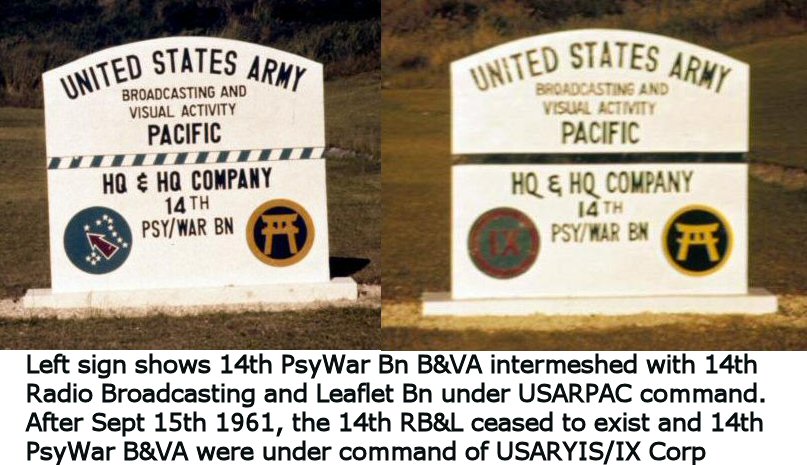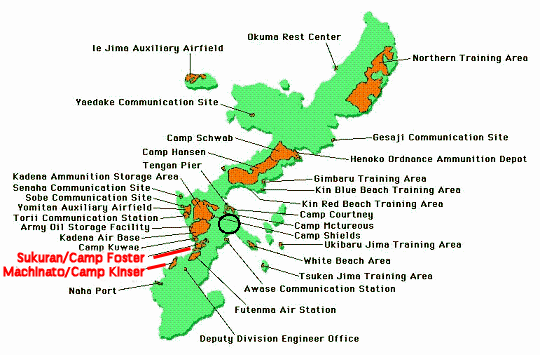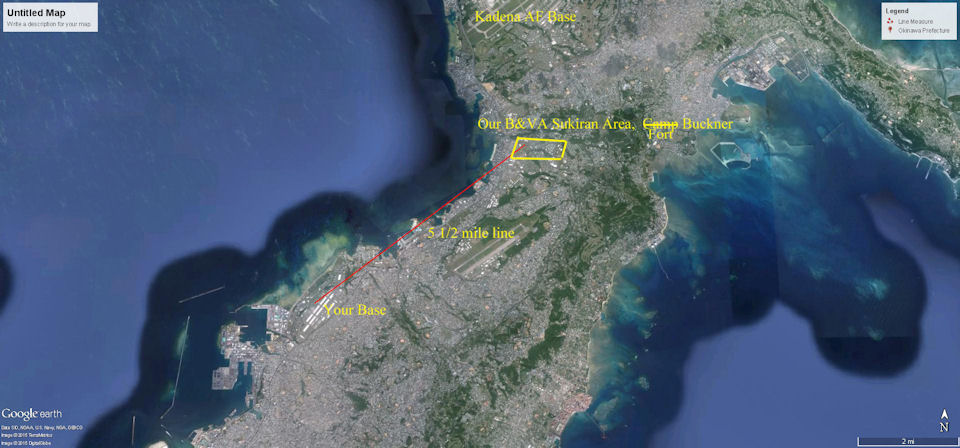In March 2015 I received an email from Gary Gloyd who indicated he had been in the 14th Radio Broadcasting and Leaflet Bn on Okinawa from 1958 to 1959. This was a revelation to me as I did not know the unit had an operational site on Okinawa during this time. I knew that some members and equipment were transferred from Hawaii as early as 1958, but I thought this was just a transitional group setting up for the reorganization to the 14th PsyWar Bn in 1961.
Mon 3/16/2015 10:31 AM
"Tim:
I belonged to this unit shortly after the two organizations, The 14th Radio Broadcasting and Leaflet Battalion (from Hawaii), and the Broadcast and Visual Activities Pacific (from Japan) were combined on Oki. I arrived about April 1958, and departed about August, 1959. I’m in touch with two other individuals who were also there at the time, one a member who had come with the 14th RBL on their move from Hawaii. I have pictures and we have a few stories. Are you interested?"
Gary Gloyd
Additional emails from Gary as well as Jon Mohr and Bruno Maselli affirmed that the 14th RB&L had a complete unit site in Sukiran including a HQ, studios, barracks, communications equipment and were functioning as Broadcasting and Visual Activity Pacific. The unit sent a team to Laos in 1958 that included Gary Gloyd. Gary was an Audio Specialists MOS 842.20 and received training at Ft Monmouth in 1956-57. John Mohr arrived by ship (USNS Barrett) with Gary in 1958. Jon spent only four months in the unit. He had a double MOS as cryptographer and crypt-accountant. The latter was phased out and he was in the last (2-man) class the army had for that job. He did basic at Ft. Dix and signal schools at Ft. Gordon, GA and Ft. Monmouth, NJ. After four months in the unit he was transferred to a Signal Company. He then went TDY on civilian status to JUSMAAG Thailand in Bangkock for three months. Then "home" to Ft Riley, KS for about 6 months awaiting discharge. Bruno Maselli went to Army Information School at Ft Slocum NY. His training was in journalism as well as radio/broadcasting and photography. He was first stationed at the 14th RB&L at Ft Shafter in June 1957. He then moved with the entire unit including a compliment in Japan to Okinawa in Jan 1958 . Their personnal tour accounts appear below.
The unit equipment consisted of fully equipped VUNC studios in the headquarters building and mothballed Korean War studio and transmitter vans and support accompaniments. Gary indicated the vans were a little rough around the edges from the long storage, but the equipment was functional. (Click for pictures including Bruno Maselli in RTTY Hut).
The 14th RB&L unit was located in Sukiran and consisted of a HQ, Studio building and barracks. Pictures of the facilities can be seen from vantage point of a water tank that served the Sukiran area. That tank or replacment appears to be still in the same location today. (Click here for pictures including the Sukiran/Buckner Area and pictures of Jon Mohr and Gary Gloyd).
The USARPAC (United States Army Pacific Command) Patch worn in Hawaii (left below) was traded for a USARYIS (United States Army Ryukyu Islands) Tori Patch. The 14th RB&L however remained under the command of USARPAC until 1961.
 |
 |
The USARPAC Patch emblem was still displayed during the transition to the 14th PsyWar Bn when the unit came under the command of USARYIS/IX Corp. The two signs below were present at the new 14th PsyWar barracks in Machinato during my (Tim Yoho) tour on Okinawa.
 |
Note: The Ft Buckner and Sukiran area where the 14th RB&L was located are now within the present day Marine Camp Foster. The Machinato area where the 14th PsyWar HQ and facilities were located is now Marine Camp Kinser as seen on map and Satellite image below.
 |
 |
Satellite Image From Gary Gloyd showing distance between The Two Locations of Machinato and Sukiran. "Your Base" was the 14th PsyWar in Machinato. |
TDY to Laos: In 1959, some members of the unit were sent to Laos including enlisted personnel Gary Gloyd, Bill Dumont, Lou Garcia and Frederick Derocher. Their mission was to train Laotians how to use the mobile broadcasting station which was also sent on the mission. Enlisted man Don Langley, and officer Major Harold F. Bentz were already there. Captain Bob Burns replaced Bentz a little later. The officers were in charge of our mission, and in addition, Don Langley worked with them in an office in town on other things which we knew little or nothing about. Others from B&VA PAC had also been here on earlier assignments--their mission(s) unknown to me (Gary Gloyd).
Since according to SEATO rules, no country could send military to neutral countries and Laos was neutral, the team had to go through a process of getting "demilitarized". They were given civilian passports, and an allowance to purchase civilian clothes. Ironic was the fact that Gary's brand new "civilian" passport photo was of him in uniform!
While in Laos Gary met Navy "Jungle Doctor" Tom Dooley. Gary describes Dooley as an impressive individual, who was really a great humanitarian. (Click for pictures of Laos TDY). More of Dooley and the TDY to Laos can be read in the personnal account of Gary below and in the online article: Dr America The Lives of Thomas Dooley. 1927-1961.
Vietnam Alerts: Bruno Maselli indicated in an email that around October of 59, many of us in B&VA were put on alert to possibly be sent to Vietnam. At that time, Vietnam was heating up more and more. The alert lasted about 2.5 months. I was one of them placed on the alert. We were to accompany the 1st Special Forces if deployed to assist their efforts. The alerts included; full field packs left on top of our wall lockers ready to go at any time, as well as access to our Carbines from the supply department on a moments notice.
We underwent at least 3 " dry runs". One included getting the full field pack, drawing your Carbine and falling out on the yard by the barracks in full formation. The second one included same as first but also included jumping onto trucks to take us to the airport which they did ( Kadena ) only to return to the barracks. The 3rd time the trucks took us to the airport, we boarded a C-130, engines started and it taxied down the run way. However it returned to the trucks without taking off. I remember thinking while sitting on those bench seats on the C-130, man oh man I'm going off to war and I didn't get a chance to write my mother to tell her. That was the last trial alert as I recall. Then came mid December and i was on my way home.
Money:
In an email from Bruno Maselli: Initially we were paid in MPC which looked like Monopoly money . We used Yen anywhere off base. However, the Okinawan yen which was different than the Japanese yen had no coins. Even " change " like 5 sen was paper and it was called sen. The day we converted from MPC to American dollars, reporting for work that morning we were told we had 30 minutes to retrieve any MPC we had, come back to the office and convert it to American money. I guess they were afraid of black market exchanges that's why we only had 30 minutes to retrieve it or lose it. Then a couple of months later we converted the Okinawan yen to American money. That proved to be too much for the cab drivers. Since they had never seen coin before they all had cardboard charts that slid over their sun visors with pictures of each American coin and what it's worth was. So before letting you out of the cab, they would make us wait until they looked at their chart holding up the coins to be sure we didn't screw them. Didn't take long before the charts were gone. There was also a flyer to introduce Okinawans to US currency.
Editor's Note: When I arrived in 1961, we were paid in a different MPC and the use of US Dollars was forbidden. Evidently the change to US dollars in 1959 led to a widescale black market since US dollars were worth more than the local currency.
Snapshots:
- Bruno Maselli standing next to Jeep that could be signed out for Weekend use
- Leaflet dropped in 1958 Water Shortage
- Tom Halloway and Bruno Maselli, B&VA 14 RBL barracks, Sukiran, Okinawa, circa 1958.
- (L to R) Ralph Parker and Jon Mohr. Day room B&VA 14th RBL Barracks. Okinawa, circa 1958.
- John Wunder (L), and Joel Haga (R). Okinawa, circa 1958.
- Joel Haga (L), and John Wunder (R). Okinawa, circa 1958.
- 1st Sgt. Clayton Warren B&VA 14th RB
- 1st Sgt. Clayton Warren and his daughter. Okinawa, circa 1958.
- Okinawa. (L to R), Roger White, Bill Neil, Gary Gloyd. At party at 1st Sgt. Warren's home. Okinawa, circa 1958.
- Day room of B&VA 14th RBL barracks. Roy Frankenhoff (L), Jim Bruhn (R)
- Camera Man John Wunder
- John Mitchel (L), and Sam Hadley (R). Looking west from hill near USARYIS Hq., Fort Buckner.
- Okinawa, Ishikawa Beach Picnic. Harold (Brick) Bentz, center with striped shorts. Sgt. Sam Hadley at right end of net. Fred Loscamp just hit the ball. About 1958.
- Okinawa, Ishikawa Beach Picnic. Fred Loscamp (L), & John Mitchel (R). About 1958.
- Naha, Okinawa, circa 1958. John Buck, had a fantastic radio voice-- very deep bass. Bruno Maselli & John were part of a training film. They did voice overs on film about a gas that was deadly. John was from Hartford, Ct..
- Okinawa, up north. (L to R) John Mitchel, Fred Loscamp, Jack Yelle. About 1958.
- Okinawa, Shuri Museum. Dick Ferris (L), Don Lutz (R). About 1958.
- Okinawa, about 1958. (L to R) Tom Forsyth, Tom Halloway, Bruno Maselli. Their "hootch".
Roster:
72 New names have been added to the organizational roster of units. Some of the indivuduals who served at both Ft Shafter Hawaii and Sukiran Okinawa were not counted as new names but their double posting was noted. (Click Here For The Roster)
After the Service:
Gary Gloyd became a CIA agent, Jon Mohr was Publisher/Editor of Medical Division periodicals dedicated to clinical laboratory management, medical technology, veterinary research, and worked in Sales and marketing positions including Account Executive, Sales Manager, Marketing Director of IMS healthcare industries. Jon was also an accomplished club level race car driver and instuctor. Bruno Maselli attended community college taking accounting courses. He then spent 42 years working in sales and sales management for the NCR Corp.
Gary, Jon and Bruno kept in touch after their tours and have had group meetings over the years.
Personal Accounts: